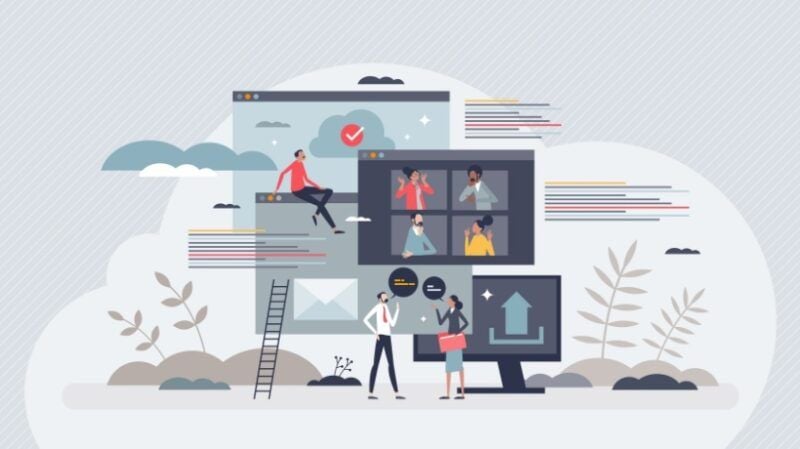Post-COVID Remote Work: How L&D Can Help With Isolation


Building Connections In A Post-COVID Remote World
The COVID-19 pandemic has drastically altered our work, pushing many organizations to adopt remote work arrangements. While remote work offers flexibility and convenience, it has also led to feelings of isolation and disconnection among employees. Learning and Development (L&D) can address these challenges by fostering a sense of community, enhancing engagement, and supporting employee well-being. Here’s how L&D can help combat isolation and disconnection in the post-COVID remote work environment.
How L&D Can Help Employees Adjust To The Post-COVID Remote Work Environment
1. Create Virtual Communities
Building a sense of community is essential for combating isolation in a remote work environment. L&D can facilitate the creation of virtual communities where employees can connect, collaborate, and support each other. Strategies include:
- Online forums and groups
Establish online and social media groups where employees can share ideas, ask questions, and offer support. - Virtual coffee breaks
Organize informal virtual coffee breaks or happy hours to encourage casual conversations and relationship building. - Interest-based groups
To bring employees together outside of work-related tasks, create groups based on common interests, such as book clubs, fitness challenges, or hobby groups.
2. Enhance Communication And Collaboration Skills
Effective communication and collaboration are crucial for maintaining connections in a remote work setting. L&D can offer training programs to help employees develop these essential skills. Strategies to incorporate are:
- Communication workshops
Provide workshops on effective virtual communication, including best practices for video conferencing, email etiquette, and instant messaging. - Collaboration tools training
Offer training on collaboration tools and project management software to ensure employees can work together efficiently. - Conflict resolution training
Equip employees with skills to handle conflicts and misunderstandings that may arise in a remote environment.
3. Foster Engagement Through Interactive Learning
Interactive and engaging learning experiences can help employees feel more connected to their work and colleagues. L&D can design programs that are not only educational but also interactive and enjoyable. Strategies include:
- Live virtual training
Conduct live virtual training sessions with interactive elements such as polls, Q&A, and breakout rooms to encourage participation and engagement. - Gamified learning
Implement gamification elements like leaderboards, badges, and points to make learning fun and engaging. - Collaborative projects
Design learning activities that require collaboration, such as group projects or peer review exercises, to foster teamwork and connection.
4. Support Mental Health And Well-Being
Employees’ mental health and well-being are critical, especially in a remote work environment where isolation can take a toll. L&D can offer programs and resources to support employees’ mental health. Strategies to incorporate:
- Wellness programs
Offer wellness programs that include mindfulness training, stress management workshops, and mental health resources. - Flexible learning opportunities
Provide flexible learning options that allow employees to effectively balance their work, learning, and personal lives. - Employee assistance programs (EAPs)
Promote the use of EAPs, which offer counseling and support services to employees dealing with mental health challenges.
5. Promote A Culture Of Continuous Learning
Creating a culture of continuous learning can help employees stay engaged and connected to the organization. L&D can promote lifelong learning and provide opportunities for professional growth. Strategies include:
- Learning paths
Develop personalized learning paths that align with employees’ career goals and interests. - Regular skill development
Offer regular skill development sessions and encourage employees to take advantage of learning opportunities. - Recognition and rewards
Recognize and reward employees for their learning achievements to motivate continued engagement.
6. Encourage Leadership And Peer Support
Leadership and peer support are crucial for maintaining a connected and supportive remote work environment. L&D can train leaders and peers to provide the necessary support. Strategies to incorporate:
- Leadership training
Offer training programs for managers and leaders to support remote teams, foster connection, and maintain morale. - Peer mentoring programs
Establish peer mentoring programs where employees can connect with and support each other. - Regular check-ins
Encourage managers to have regular check-ins with their team members to provide support and address concerns.
7. Utilize Technology To Connect And Engage
Technology can bridge the gap created by physical distance. L&D can leverage technology to create immersive and engaging learning experiences. Strategies include:
- Virtual Reality (VR) and Augmented Reality (AR)
VR and AR can be used for immersive training experiences that bring employees together in a virtual space. - Social learning platforms
Implement social learning platforms where employees can share knowledge, collaborate on projects, and engage in discussions. - Mobile learning
Provide mobile learning options to ensure employees can access training and resources anytime, anywhere.
Conclusion
The post-COVID remote work environment presents unique challenges, but Learning and Development can be pivotal in mitigating feelings of isolation and disconnection. By creating virtual communities, enhancing communication and collaboration skills, fostering engagement through interactive learning, supporting mental health and well-being, promoting a culture of continuous learning, encouraging leadership and peer support, and utilizing technology, L&D can help build a connected, engaged, and resilient remote workforce. Investing in these strategies will improve employee well-being and drive organizational success in the new world of work.
Source link





